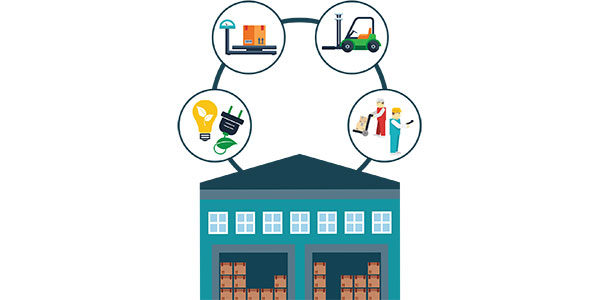Four ways your WMS can cut costs and "green up" your DC

A bustling distribution center is a crucial cog in most logistics operations, but these busy facilities can also run up big bills of their own, not to mention suck up energy. In the relentless search to cut costs and "green up" their distribution operations, many companies are turning to an unlikely tool—their warehouse management system (WMS).
DCs have traditionally used their WMS platforms to direct basic material handling operations, such as planning a swift, efficient path for moving goods through the DC and directing complex tasks like picking and shipping. That hasn't changed. But now, some are finding that every time the WMS identifies a wasteful step in a distribution operation, it's also an opportunity to trim the building's power bill—cutting costs and saving the planet at the same time.
The typical DC incurs expenses around the clock, burning electricity to keep the lights on and conveyors humming, hosting up to three shifts of pickers and drivers each day, and heating or cooling large volumes of air. Reduce that electric bill, and a DC manager can cut the company's utility costs and shrink its carbon footprint. That's good for company budgets, the environment, and the corporate image. The only problem is figuring out how to get it done.
With the ability to instantly analyze thousands of moving pieces in a complex logistics operation, WMS software can provide the answer. For example, the software might be able to uncover opportunities to save energy by cycling conveyor belts off during idle times or using occupancy sensors to switch off lights in empty rack aisles.
"You can use a WMS both to run a warehouse most efficiently and to get maximum productivity," says Jason Mathers, senior manager for supply chain logistics at the Environmental Defense Fund (EDF), an advocacy group that partners with companies to find ways to reduce their environmental impact. "The goal is (to figure out) how to run a variable volume through a distribution center," Mathers says. "These are very dynamic environments. You want to be able to scale up how you use equipment to meet peak demand, but you don't want your system optimized for peak flow when it's the slow time of year."
When it comes to energy-saving strategies, Mathers speaks from experience. Through its Climate Corps program, EDF matches business school students with companies on 10-week fellowships to find energy savings that benefit both the environment and the bottom line. Companies that have enlisted these specialists to identify savings opportunities in their warehouses include Adidas AG, Coinstar, Mondelez International Inc., Target Brands Inc., and Recreational Equipment Inc. (REI).
The results can be jaw-dropping. For instance, in 2013, Office Depot Inc. brought a Climate Corps intern into its retail and supply chain operations in Boca Raton, Fla., and identified potential long-term savings opportunities of $6 million in its building systems and operations alone, thanks to annual electric savings of 32,000,000 kWh and an annual reduction in carbon dioxide emissions of 16,000 metric tons.
Not all companies will uncover savings of this magnitude, of course, but that's not to say they shouldn't give it a try. They might be surprised by how much waste they can root out. "There are energy efficiency opportunities just waiting to be found," says Mathers.
So how do you go about identifying those opportunities—and where does your WMS fit in? What follows are four ways to leverage the power of software to cut both warehouse costs and your carbon footprint:
1. Buy electricity at off-peak rates. A large warehouse can cut its electric bill by participating in a demand response program with its local utility, Mathers says.
For power companies, the cost of producing electricity varies widely across days or even hours, such as when a producer has to fire up additional generators to meet peak demand or when low rainfall causes a hydroelectric dam's production to drop. The price we pay for electricity, however, does not fluctuate in most places (except in regions that have deployed smart meter technology).
To compensate, some utilities will actually pay large customers—such as warehouses—to shut down key pieces of equipment during periods of peak demand. A DC that can use its WMS to ramp down operations at key times and reschedule them for nonpeak periods can reap a big return.
"The cost of generating one more kilowatt of electricity at 4 p.m. on a hot day in Texas is quite significant," Mathers says. "So this is one way for companies to reduce their power bill and their carbon footprint."
2. Rein in forklift costs. Seasonal and cyclical factors can have a big effect on warehouse energy costs. Rising oil prices can boost the cost of operating trucks and forklifts, and the extremes of winter cold or summer heat can punch a hole in any heating or air conditioning budget.
"The pressure to save money in warehouses goes up with variables like fuel costs," says Thomas Kozenski, vice president of industry strategy for JDA Software Group Inc. "Because people have budgets, if gas prices suddenly go bananas, they've got a problem. And they will do something—anything—to cut those costs."
One way to slash fuel costs is to use the WMS to identify wasteful forklift travel patterns. Whether the facility runs lift trucks powered by propane or by batteries, it will save money and energy by finding shorter, more efficient routes, Kozenski says.
Another approach is to calculate the smallest number of forklifts a facility needs to get the job done. A surefire way to avoid rising fuel bills—and emissions—is to avoid buying that extra forklift in the first place.
"That could allow a user to use eight forklifts, whereas if you didn't have a WMS, you might need 10 or 12 forklifts to get the work done," Kozenski says.
3. Cut packaging waste. A WMS application can also shrink warehouse costs by cutting waste in packaging. If you're running a high-volume fulfillment and shipping operation, chances are, you're shipping part of your profits out the door every day.
"Part of sustainability is figuring out how you can use less material to get the job done," says Kozenski. "You get boxes at home delivered by UPS, filled with popcorn, white Styrofoam, or shredded newspaper."
Many WMS platforms can calculate the optimal "package profile," that is, the minimum size box and smallest amount of packing material needed to prevent damage to the package's contents during shipping. The result is an instant reduction in material costs and environmental impact, but there are additional benefits.
Thanks to the compact design, those smaller boxes can be packed more densely onto a truck, while reducing the potential for damage during transport. This approach can also save money on shipping costs at a time when both UPS Inc. and FedEx Corp. have adopted dimensional weight pricing for ground shipments, charging more for packages with greater volume.
4. Boost labor efficiency. Workers cost money, whether it's measured in salaries or the cost of keeping a workspace warm, well lit, and ventilated. That means DCs can cut costs by helping pickers do their jobs more efficiently, using an approach called "system-directed work."
Built into many WMS applications, this function identifies ways to avoid unnecessary travel between racks, shelves, and pick stations. Instead of requiring pickers to return to a central location after finishing each task, a warehouse can use radio-frequency (RF) equipment or voice technology headsets to immediately direct them to the next task.
"We tell the operator what to do, then what to do next, then what to do next, then what to do next," Kozenski says. "The workers love it—they can just do their job, and at the end of the day, they get to go home and have a beer."
This approach is also helpful for training new hires, a task that can be a full-time job in an industry where employee turnover runs as high as 20 percent per year, he says. Once a client has loaded a detailed warehouse map into its WMS, the system can easily direct new hires to the location of a certain aisle, row, or shelf.
A PAYOFF ON SEVERAL LEVELSCutting warehouse costs by reducing fuel consumption, electric bills, and greenhouse gas emissions is an investment that pays off both in more sustainable operations and in bottom-line profits. However a company justifies the decision to run a more efficient distribution center, it will see a payback on several levels.
"Some companies are more interested in green operations and sustainability than others, but everybody is interested in cost savings," Kozenski says. "Efficiency is not a separate application.
"We're in a world where all our customers are in continuous process improvement (mode)," he adds. "They are always looking for an additional way to save a little more money."
Related Articles

Copyright ©2024. All Rights ReservedDesign, CMS, Hosting & Web Development :: ePublishing